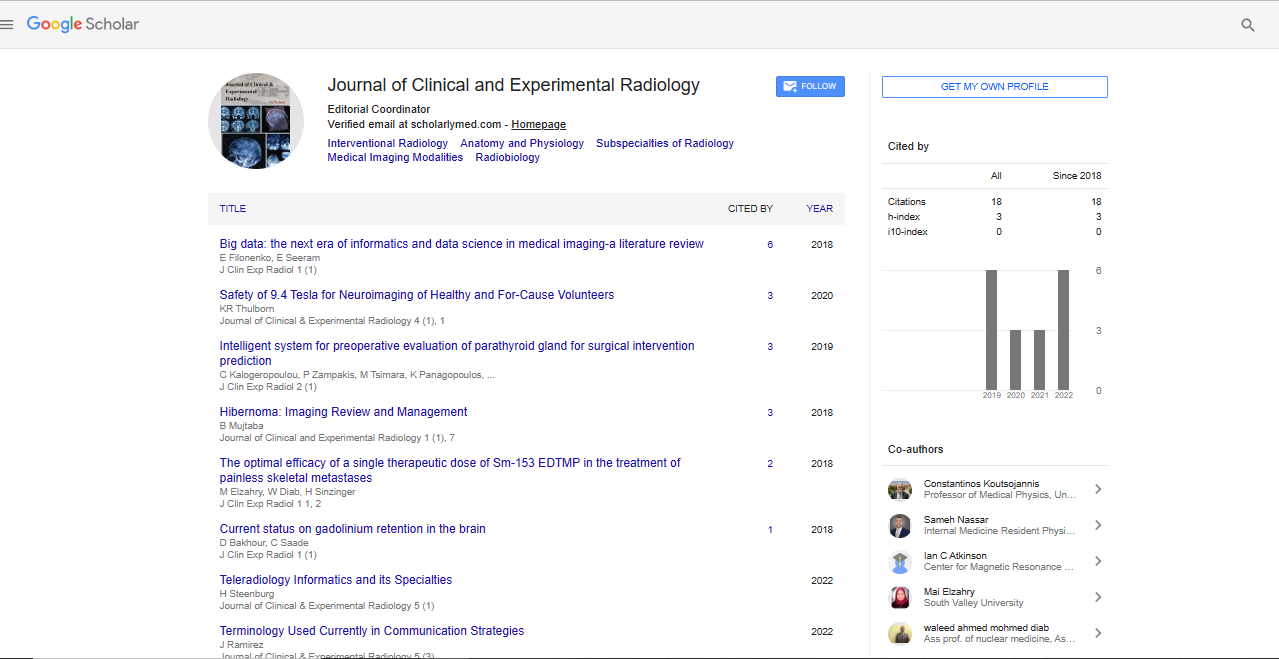Perspective, J Clin Exp Radiol Vol: 6 Issue: 2
Imaging Techniques for Evaluating Lung Diseases
Akira Hida*
1Department of Chest Surgery, Affiliated Hospital of Guangdong Medical University, Zhanjiang China
*Corresponding Author: Akira Hida,
Department of Chest Surgery, Affiliated
Hospital of Guangdong Medical University, Zhanjiang China
E-mail: akira@hida.edu
Received date: 28 May, 2023, Manuscript No. JCER-23-106679
Editor assigned date: 31 May, 2023, Pre QC No. JCER-23-106679 (PQ);
Reviewed date: 14 June, 2023, QC No. JCER-23-106679
Revised date: 22 June, 2023, Manuscript No. JCER-23-106679 (R);
Published date: 28 June, 2023, DOI: 07.4172/jcer.1000139
Citation: Hida A (2023) Imaging Techniques for Evaluating Lung Diseases. J Clin Exp Radiol 6:2.
Description
Lung diseases encompass a wide range of conditions, including infections, inflammations, structural abnormalities, and malignancies. Accurate diagnosis and evaluation of lung diseases are crucial for appropriate treatment planning and monitoring disease progression. Imaging techniques play a vital role in the evaluation of lung diseases, providing detailed anatomical and functional information. This article aims to discuss various imaging modalities commonly used in the assessment of lung diseases, including chest X-ray, Computed Tomography (CT), Magnetic Resonance Imaging (MRI), and Positron Emission Tomography (PET).
Chest X-ray is a widely accessible and commonly used initial imaging modality for evaluating lung diseases. It provides a twodimensional radiographic image of the chest, including the lungs, heart, and surrounding structures. Chest X-ray is valuable in detecting abnormalities such as consolidations, infiltrates, nodules, and pleural effusions. It is often used as an initial screening tool for lung diseases, providing an overview of the lung parenchyma and detecting gross abnormalities. However, it has limited sensitivity and specificity for detecting subtle lung pathologies. CT imaging has revolutionized the evaluation of lung diseases due to its superior spatial resolution and multiplanar capabilities. CT scans provide detailed cross-sectional images of the lungs, allowing for better visualization of lung structures and abnormalities. CT is highly sensitive in detecting pulmonary nodules, consolidations, ground-glass opacities, and interstitial lung diseases. It is particularly useful in diagnosing lung cancer, assessing tumor size, staging, and evaluating treatment response. CT angiography is employed for assessing pulmonary embolism, while High-Resolution CT (HRCT) is valuable in evaluating diffuse lung diseases such as interstitial lung disease and fibrosis.
MRI is not routinely used as the primary imaging modality for evaluating lung diseases due to challenges related to lung motion artifacts and limited spatial resolution. However, it has unique capabilities for providing functional and metabolic information. MRI can be utilized for specific indications, such as evaluating mediastinal masses, characterizing pulmonary nodules, and assessing lung perfusion. It is particularly valuable in assessing chest wall invasion in lung cancer and evaluating pulmonary vascular abnormalities.
PET imaging, in combination with a radioactive tracer, is used to assess lung diseases based on metabolic activity. It is commonly employed in the evaluation of lung cancer and the detection of metastatic disease. PET scans provide information about cellular metabolism, allowing for the detection of malignancies and monitoring treatment response. The combination of PET with CT (PET/CT) provides both anatomical and functional information, enabling precise localization of abnormalities and improved diagnostic accuracy.
Several emerging imaging techniques show promise in the evaluation of lung diseases. Dual-Energy CT (DECT) imaging allows for better characterization of pulmonary nodules and differentiation between benign and malignant lesions based on their material composition. Functional imaging techniques, such as Ventilation/ Perfusion (V/Q) scans and hyperpolarized MRI, provide insights into lung ventilation and perfusion abnormalities. These techniques are particularly valuable in assessing lung function and identifying regional lung diseases.
Imaging techniques play a crucial role in the evaluation of lung diseases, allowing for accurate diagnosis, characterization, and treatment planning. Chest X-ray remains the initial screening tool, while CT imaging provides detailed anatomical information and is particularly useful in detecting pulmonary nodules and assessing lung cancer. MRI and PET imaging offer additional functional and metabolic information but are typically reserved for specific indications. Emerging techniques, such as DECT and functional imaging modalities, continue to advance the field of lung disease evaluation. A multimodality approach, considering the strengths and limitations of each imaging modality, is essential in achieving accurate diagnosis and optimal patient care in the management of lung diseases.
 Spanish
Spanish  Chinese
Chinese  Russian
Russian  German
German  French
French  Japanese
Japanese  Portuguese
Portuguese  Hindi
Hindi 